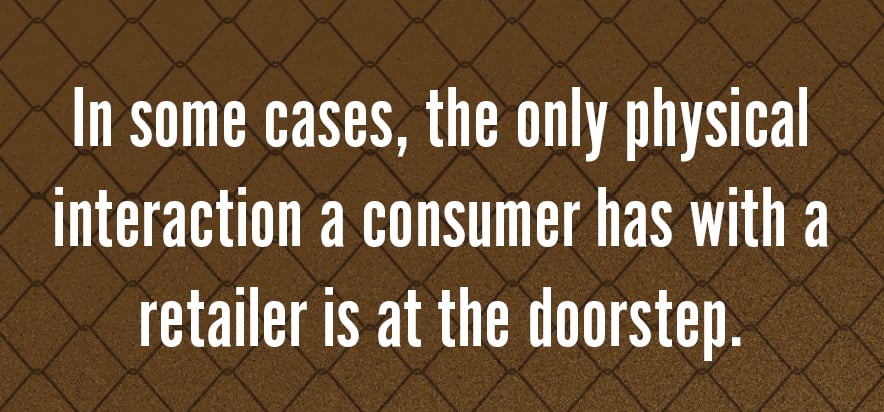Curbing Theft at the End of the Last Mile
E-commerce spiked during the COVID-19 pandemic, and it shows no sign of slowing down. Consumers ordered medicine, groceries, electronics, and more in record numbers as officials encouraged them to stay at home. Online shopping—especially when done from a mobile device or smartphone—has increased for consumers across the world, according to a September 2021 PricewaterhouseCoopers (PwC) survey.
“Forty-one percent of respondents say they shop daily or weekly via mobile or smartphone, compared with 39 percent six months ago and 12 percent five years ago,” PwC reported in its December 2021 Global Consumer Insights Pulse Survey. “Only 6 percentage points separate mobile shopping from in-store shopping.”
Packages were left at doorsteps, porches, and mailboxes daily—tempting so-called porch pirates to roam neighborhoods in search of goods to steal.
Package theft has emerged as one of the most common types of crime in the United States. This is not only aggravating for consumers, but it carries legitimate security and risk implications for any business seeking to safeguard the last few feet of its product’s journey.
The theft occurs during the trip from the store to the consumer’s doorstep, a distance often referred to as the last mile. Package theft is different from mail or cargo theft, however; the author and fellow researchers define it as “taking possession of a package or its contents, outside of a residence or business, where it has been commercially delivered or has been left for commercial pick-up, with intent to deprive the rightful owner of the contents.”

While package theft and porch piracy are relatively new terms to the industry’s lexicon, their impact on the retail sector is already notable. A 2016 study by smart door lock manufacturer August Homes found that nearly 11 million consumers were victims of package theft. A recent study by SafeWise estimated that 210 million packages were stolen in 2021. Assuming an average value of each package at $25, the impact of porch pirates in the United States in 2021 was more than $500 million.
With the spread of COVID-19, consumer habits dramatically shifted in early 2020—more people were purchasing items online that were then delivered to their homes, as reflected in the SafeWise study. The buy-online boom has somewhat slowed from its peak, yet it remains strong and likely signals a permanent shift in consumer behavior. It also means that, in some cases, the only physical interaction a consumer has with a retailer is at the doorstep.
As a result, there is another shift occurring, where traditional risks from retail shrink within brick-and-mortar stores are increasingly hitting home or arriving at consumers’ porches. Porches are no longer solely an extension of a residence—they are now a commercial center, and thieves know it.
Methods of Marauding
Porch piracy has minimal risk for offenders and a low cost of entry—no special skills are required to carry off a box. In addition, significant social media coverage of package theft likely leads to greater awareness of new and effective techniques among criminals.
It is difficult to measure the full scope of package theft, however. Most U.S. states lack adequate laws addressing the theft of packages not delivered by the federal U.S. Postal Service (especially as many online commerce companies use non-government or contract delivery services), resulting in lax law enforcement and investigations.
Most victims of package theft do not report the incident to police or insurance providers, so these crimes are rarely officially recorded. Instead, victims most often turn to the retailer for refunds or replacement items, and—in most cases—merchants replace the item and take the loss without specifically identifying where the loss occurred in the last mile. Few, if any, retailers share data on losses from package theft, focusing instead on attempts to placate customers and protect brand reputation. The result is a perfect storm confronting retailers and consumers, making understanding the crime and enacting effective countermeasures difficult endeavors.
The author and fellow researchers conducted a study, Porch pirates: examining unattended package theft through crime script analysis, in 2020, analyzing 67 YouTube videos of package thieves in action to gather data. They used their findings to create a Crime Script Analysis, which described porch pirates’ actions, demographics, targets, and methods.
Pirates. There was a nearly even split on the gender of porch pirates, which is unusual for most crimes. Based on the video data, these offenders tended to be younger than 45 years of age (95 percent) and had a societally reflective distribution of race and ethnicity—54 percent were Caucasian, 15 percent Black, 9 percent Hispanic, and 3 percent Asian.
Very few pirates appeared to case the home (only 12 percent), and even fewer (8 percent) attempted to disguise their appearance during their actions. The use or appearance of gates, fences, cameras, and homeowners’ cars did not appear to dissuade thieves. Most casually walked up to the doorstep (72 percent), did not attempt to see if anyone was home (73 percent), and subsequently ran away after picking up the package. More than 60 percent used a vehicle to escape—typically pulling right into a victim’s driveway. Two-thirds of observed thieves (63 percent) had an accomplice, usually a driver.
Packages. The study also identified 98 packages stolen from residents, with most thefts occurring within 25 feet of a roadway (61 percent). Nearly all of these items were visible from the roadway (93 percent). Additionally, 46 percent of the stolen packages had a brand visible on the box, and nearly half of the packages were medium-sized—approximately 13 to 36 inches.
It was infrequent for a package to be opened on site, occurring in just 3 percent of cases. In only a few cases (10 percent), thieves made multiple trips onto the property to gather all the packages.
Everyone’s a Loser
Package theft has been growing for years, with few concerted efforts to confront the issue. A retailer may view a package leaving its warehouse or store on a delivery truck as a completed sale. The delivery company leaves a package unattended outside a home, which transfers ownership to the intended recipient in most U.S. states. For the homeowner who never receives a stolen package, however, he or she is most likely to blame the retailer.
Ultimately, nearly everyone along this vertical loses. The consumer fails to receive the item promptly. Delivery services divert resources into investigating missing packages. The retailer must investigate losses and decide whether to replace items, bearing the cost of the stolen items and additional replacement shipping.
While retailers and delivery services may not be liable for the theft, they are carrying the brunt of the impact. Fifty-two percent of respondents who previously identified as victims of package theft reported the theft to the shipping company, but 77 percent filed a complaint with the retailer, according to the 2019 survey Fear of Package Theft: A Survey of Online Retail Customers. Whether rightly or wrongly, victims of package theft seem to hold the retailer responsible for the loss.

Additionally, 34 percent of victims took steps to avoid future thefts, using methods including purchasing cameras and lockable package receptacles, or requesting delivery to an alternative address. Some went so far as to avoid buying expensive items online due to fear of theft (23 percent).
Beyond altering purchasing behavior, victims spurred by fear may shift to other retailers. These behaviors can severely impact retailers financially—companies that often already absorb the costs of replacing an item and risk losing future sales.
Retailers should consider the experience and safety at the customer’s porch or front step in the same way they consider the customer experience at a traditional brick-and-mortar store.
Thankfully, this is beginning to occur on a broad scale. Companies are responding to package theft by implementing many techniques, including drone delivery, scheduled drop-offs, parcel lockers, delivery inside consumers’ homes, and more. For example, Amazon offers customers the option to have their purchases delivered to a secure locker at nearby Whole Foods locations. Amazon also offers an in-home delivery service for customers whose homes utilize certain smart home features—within a delivery window, a driver can request to unlock a customer’s door using an Amazon handheld scanner and, upon verification and while being monitored, the package can be left inside the building instead of on the front porch. The driver then exits, locks the door, and continues on his or her route.
The Last Foot
Recent consumer behavior indicates that home delivery is here for the long haul. The front porch, previously seen as mainly a facet of a neighborhood’s social setting, has been stretched and shifted to include a crucial aspect of e-commerce. And due to shifts in criminal activity during the COVID-19 pandemic, package theft is likely to continue increasing in step with consumer buying trends.
Within the last mile is the most critical stage and one of the most vulnerable points of the entire supply chain—the last foot. This is the distance between where the package is left on the porch or doorstep to when it reaches the intended recipient’s hands. Securing the last foot requires a combined effort between consumers, retailers, delivery services, and law enforcement.
The best way to tackle this problem that costs retail and consumers millions annually is to rethink the porch.
Retailers. Retailers must evaluate a loss occurring within the last mile to identify at which point in the supply chain that the package is stolen.
Using this information, they can partner with consumers to encourage or require appropriate responses, such as directing delivery to post office boxes or private lockers, pick-up drop-off (PUDO) locations, or purchasing delivery insurance.
Further, retailers should consider the risks of using packaging that reveals the box’s contents—specific brands, logos, or products could attract thieves.
Packaging and shipping. Packaging companies can help mitigate package theft through a crime-conscious approach to readying an item for shipping. Reducing the size of a box, using muted or subdued colors, removing or covering any visible branding from a box, and using tamperproof tape are all tactics that can camouflage a package’s contents.
Delivery companies can also take small—but meaningful—and targeted steps to reduce the likelihood of thefts. This includes notifying consumers when a package arrives, whether through an app, email, text, knocking on the door, or ringing the doorbell. Company instruction or training can direct delivery personnel to leave packages behind an item on the porch—such as planters or columns—which may reduce the package’s visibility from the street. Packages with brands and lithium battery labels (which clue thieves to the contents) can be placed on a doorstep facedown, eliminating the label’s visibility.
Consumers. Ideally, consumers should remove packages from the porch as soon as they are delivered. If someone is unable to do this, consider delivering a package to a trusted neighbor or a more secure location, such as an office building, a P.O. Box, a private locker, or a PUDO location. Other alternatives could include using a container like a home parcel locker placed on the porch that can house packages—useful if consumers live close to a roadway, in a high crime area, or frequently receive valuable items.
Police and government leaders. Currently, most U.S. states do not have sufficient laws aimed at combatting porch piracy, but updating or developing new legislation to track, report, deter, or appropriately penalize package theft could help.
Further, tracking thefts will allow for a more robust understanding of how, when, and where package theft occurs and which people or organizations are behind these crimes. Since package thefts often cluster in occurrence, prevention methods—such as coordination with neighborhood watch groups—and encouraging the use of social media to alert homeowners may be helpful.
Ben Stickle is an associate professor of criminal justice at Middle Tennessee State University. His work has been featured in Mail and Express Review, Loss Prevention Magazine, Business Insider, “Good Morning America,” The New York Times, AARP, and many others.












